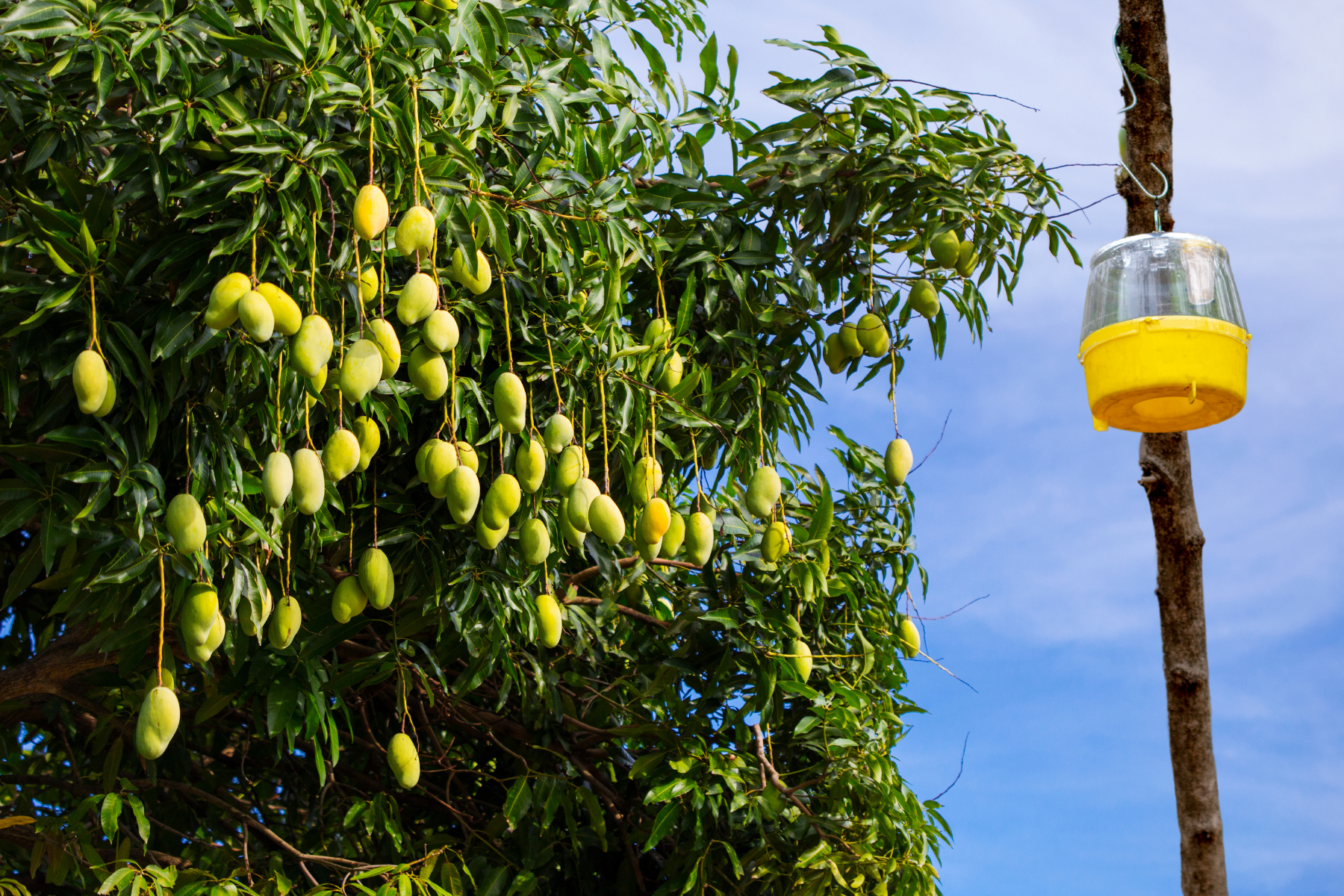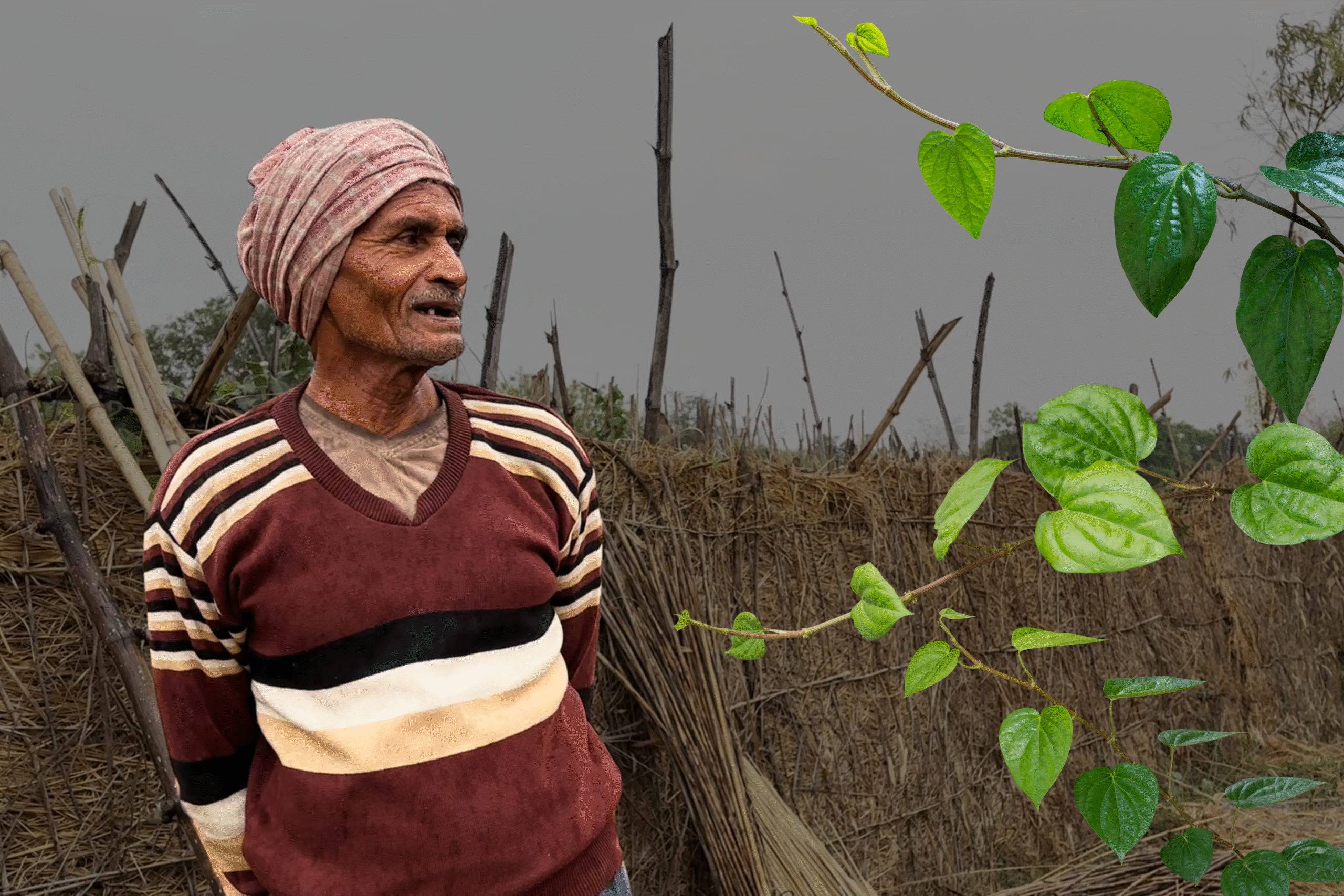Upon receiving a request from the Alwar district administration, the Indian Air Force deployed two Russian-made Mi-17 V5 to extinguish the fire blazing in the forests of the Sariska Tiger Reserve on March 29. The two choppers carried out sorties, pouring water from the above on the burning patches as part of the ‘Operation Bambi Bucket’.
When Gaon Connection approached the forest officials of the tiger reserve, it was learnt that the fire, which began on March 27 has been substantially controlled now.
At the behest of Alwar Dist admin to help control the spread of fire over large areas of #SariskaTigerReserve, @IAF_MCC has deployed two Mi 17 V5 heptrs to undertake #BambiBucket ops.
Fire Fighting Operations are underway since early morning today.#आपत्सुमित्रम pic.twitter.com/HhGEHsdYrS
— Indian Air Force (@IAF_MCC) March 29, 2022
Satendra Sharma, the divisional forest officer (DFO) of the tiger reserve told Gaon Connection that the fire had spread to 10 square kilometres (sq. km). “Out of the total area of 1,200 square kilometres, only 10 square kilometres has been affected, and that’s because of the preventive measure of forest lines that was laid,” Sharma said.
The blaze in Rajasthan’s tiger reserve on March 27 wasn’t an isolated incident as according to the official data provided by Forest Survey of India, at least 1,026 cases of ‘large fire events’ were reported in the two days — on March 30 and March 31. Chhattisgarh and Madhya Pradesh reported the highest number of fire incidents in the given period with 200 and 289 cases respectively followed by Odisha which reported 154 such cases.
The Forest Survey of India report 2021 underlined that 10.66 per cent area of forest cover in India falls in the category of ‘extremely to very highly’ fire-prone zone.
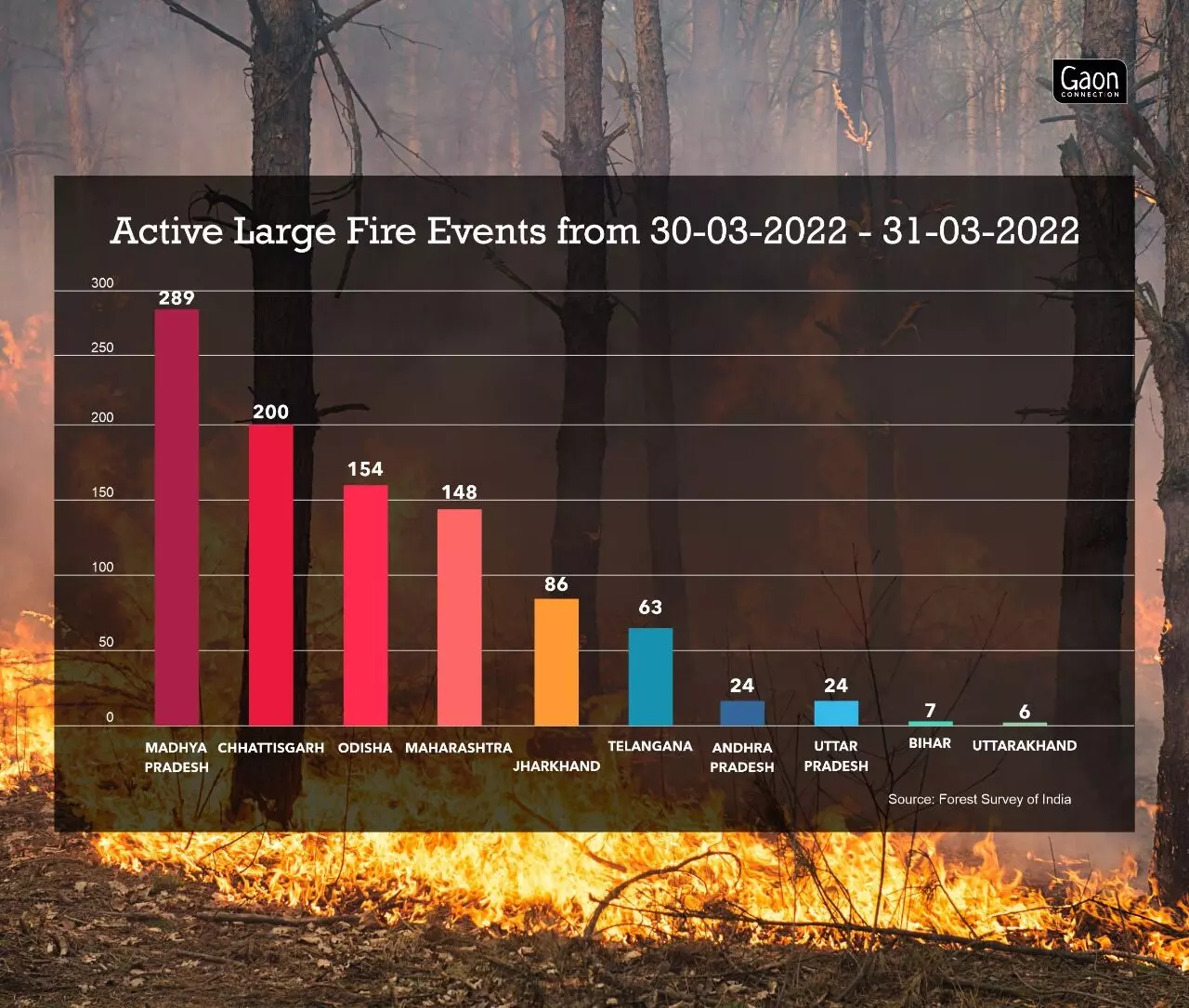
Also Read: Forest fire: Over 2,500 ha of Uttarakhand forests burnt to ashes since January this year
What drives forest fires?
While the reason behind the forest fire in Sariska is unknown, DFO Sharma told Gaon Connection that the fire was ‘natural’.
“In dry forests, as soon as heat rises, the threat of fire is high. As such we don’t know the reason behind the fire, we will try to figure it out once we have doused the fire but generally the forest fires continue to happen during the summer season,” Sharma told Gaon Connection.
Climate change experts Gaon Connection spoke to highlighted that one of the major factors which drive forest fires is dryness and an increase in temperature leads to dryness.
“CEEW (Council on Energy, Environment and Water) had found that 75 per cent of Indian districts are extreme hotspots, out of which 68 per cent are witnessing drought or drought like conditions where precipitation and wetness index is quite low,” said Abinash Mohanty, the programme lead at CEEW, a Delhi based non-profit.
“The western winds from the Atlantic ocean and other places which actually bring a lot of colder air are getting trapped and unable to come in. Additionally, we have local micro-climatic changes that are contributing to the dryness. Winter is normally a dry season so after winter, you have a huge accumulation of dry lakes and other forest flammable substances. Wherever there is a trigger source of fire, it just escalates. It spreads quite fast – that is one of the reasons,” he added.
Also Read: Nepal’s forest fires under control, but peak wildfire season has just begun
The climate expert also observed that drying up of springs and temperature rise is also leading to a lot of forest fires.
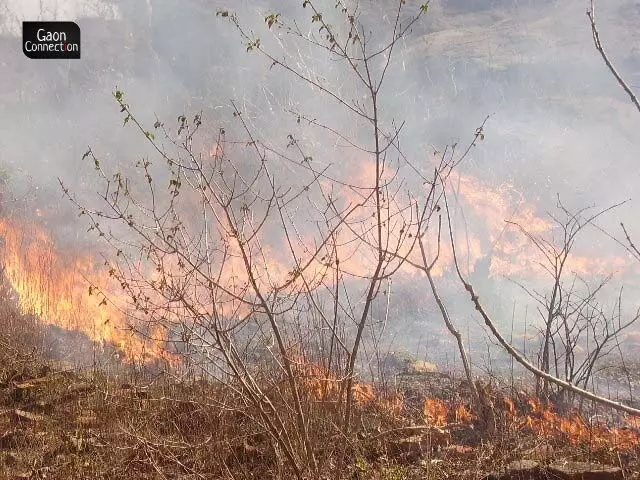
It is also important to note that in its press release on March 26, a day before the fires engulfed the Sariska forests, the Indian Meteorological Department (IMD) stated in its press release that a gradual rise in maximum temperature by two to three degrees celsius is likely to be over most parts of Northwest and Central India during the next four days (March 27 – March 30).
“Isolated heat wave conditions are very likely over Western Himalayan region and Gujarat during next three days; over West Madhya Pradesh, Vidarbha and Rajasthan during next four to five days; and over south Punjab, south Haryana, Bihar, Jharkhand, north Madhya Maharashtra & Marathwada during March 29 to 31, 2022,” the press release read.
Also, a research study titled Investigation of Forest Fire Activity Changes Over the Central India Domain Using Satellite Observations During 2001–2020 which was conducted by Madhavi Jain, Pallavi Saxena, Som Sharma, and Saurabh Sonwani published in GeoHealth journal also noted that owing to warmer conditions in the Indian subcontinent from 2006 to 2020 (as compared to 2001–2005), a doubling and tripling of forest fire activity was noted in forest fire and non-fire seasons, respectively. The study further highlighted the role of multiple simultaneous climate extremes such as El Niño, heat waves, weak Indian summer monsoon, and droughts in causing anomalously high fire activity periods over central India.
In a contrary vein, Divya Gupta, senior research fellow with the School of Public Policy at Indian School of Business, Hyderabad, who has worked extensively on natural resource governance issues for almost a decade observed that the issue of forest fires needs to be unpacked and explored more.
“There are multiple reasons behind forest fires, at the outset, it might seem that it is drier days and higher heat causing the higher numbers of forest fires, and these eventually become part of the climate change narrative wherein the responsibility for natural disasters like the forest fires is attributed to climate change and the buck normally stops there,” she told Gaon Connection.
Also Read: Odisha forest fires: Similipal Tiger Reserve continues to burn; Kuldiha sanctuary in flames too
Additionally, she said that the back-to-back forest events are alarming and need to have a better response from the stakeholders.
“These are the warning signs that there needs to be better forest fire research, preparedness and response, which unfortunately are severely lacking in our country,” Gupta said.
‘Not all fires are due to natural factors’
While Odisha and Madhya Pradesh have reported high incidences of forest fires recently however Biswajit Mohanty, secretary of Wildlife Society of Odisha and former member of National board of Wildlife completely ruled out any link between climate change or heat rise and climate change.
“At least in Odisha, 99 per cent of the fires are man-made fires and when there are long dry periods without rain then the problem becomes acute. In Odisha, there is no change in the temperature, this is the normal temperature at this time of the year,” he told Gaon Connection.
The Wildlife Society of India functionary added that the detection level because of FSI’s satellite imagery is another reason behind high reporting of forest fire incidents.
Adding to the discourse, Gaurav Sharma, DFO, North Panna, Madhya Pradesh told Gaon Connection that the most incidences of forest fires take place in the summer season because of Mahua flowers that bloom in this season. Villagers who pick Mahua flowers often ignite fire in the forest to get rid of the dry leaves so that picking of Mahua flowers is easier for them which is a big factor behind spreading of forest fires in that region, the DFO noted. In addition to that, sometimes forests also catch fire due to the negligence of villagers who discard leftover cigarettes in the forest without putting them out.
The DFO also informed that preventive measures include setting of fire lines at numerous places and of forest guard. As on April 1, areas such as Panna, Jhinna, Ranipur, Dehlan Chaki, Banhari and Patha were among the villages that witnessed forest fires.
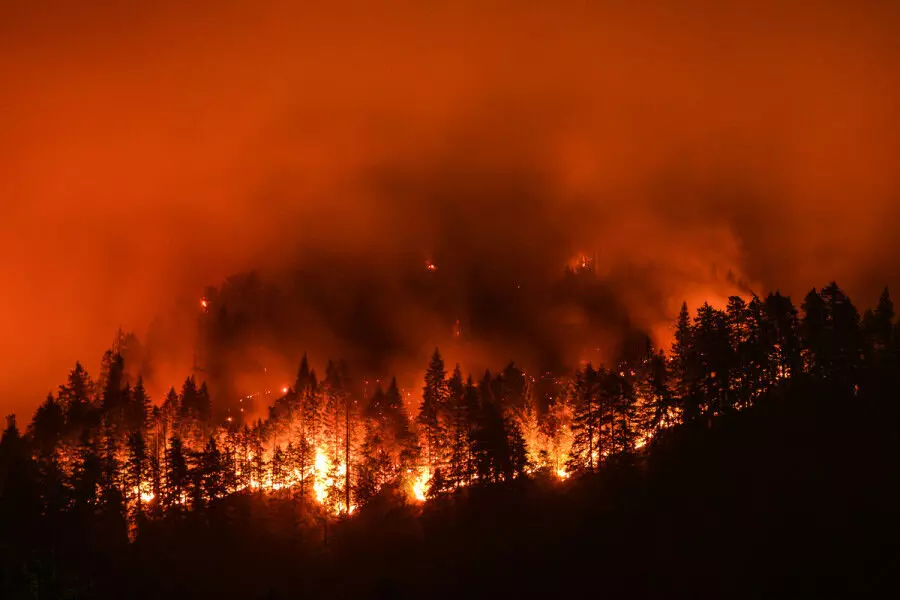
Preventive measures
Talking about the preventive measures that are taken to mitigate forest fires, DFO of Sariska Tiger Reserve said that forest lines are spread every year to ensure minimal spread of fire.
Highlighting the importance of having a preventive measures that need to be integrated with the local knowledge and local communities, Mohanty said, “Until and unless you bring the communities together, that are actually dependent on forest and have preventive measures based on forest type and the climate type in that region through a granular risk assessment you cannot manage forest fire better. You might end up spending a lot of billions of dollars in terms of management but at the end of the day this will only aggravate because of this clear mismatch”.
On similar lines, Biswajit Mohanty added that in Odisha, preventive measures are completely local based. “99 per cent of these are based on the local community. We have seen in Odisha, wherever the locals are proactive, they have ensured that fire won’t take place, there we have seen successful fire fighting and not a single acre of forest was being burnt,” he told Gaon Connection.
He also suggested that the government should set up a strategy to ensure that villagers are provided with an incentive to not ignite fire in the forest area.
The United Nations Environment Programme (UNEP) also recommended “supporting and integrating indigenous, traditional and contemporary fire management practices into policy” in its report titled Spreading like wildfire: The rising threat of extraordinary landscape fires that was released on February 23.
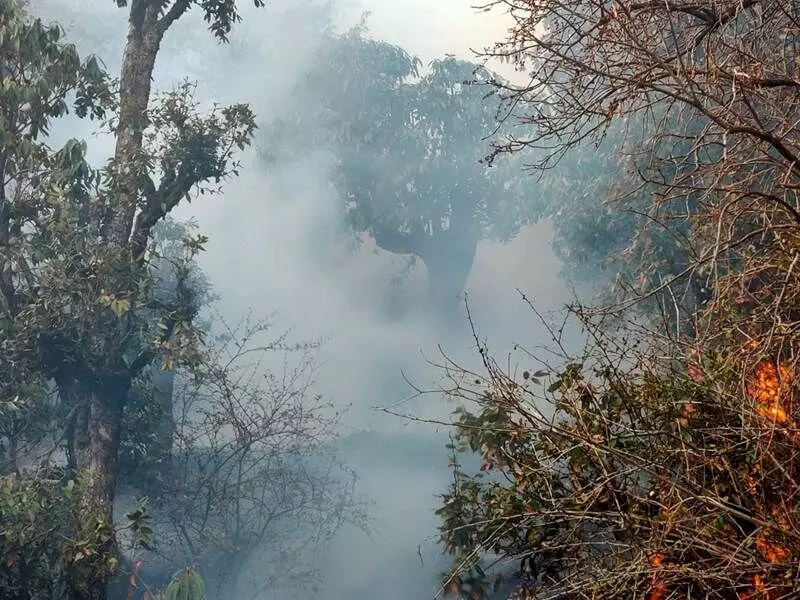
“Indigenous and traditional knowledge of land management in many regions – particularly the use of fire to manage fuel, including for wildfire mitigation – can be an effective way of reducing hazard. It can also ensure that biodiversity, and cultural (including understanding traditional gender roles that can govern burning activities) and ecological values are respected, as well as create livelihood opportunities,” the report read.
Adding to this, Gupta told Gaon Connection that there should be a way to model the trends and have the data predict and caution in advance with regard to the forest fires.
Meanwhile, on March 31, the forest department officials reportedly arrested five persons for setting a portion of Simlipal Forest Reserve on fire. The local people were blamed for the fire which they allegedly ignited to hunt wild animals and burn dry leaves to collect mahua flowers.
(With inputs from Arun Singh in Panna, Madhya Pradesh)


